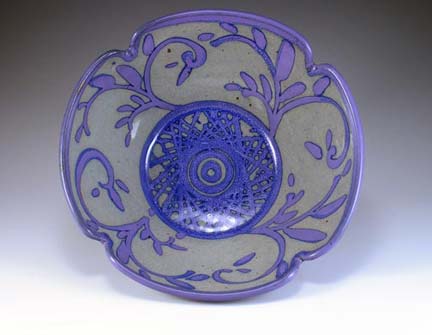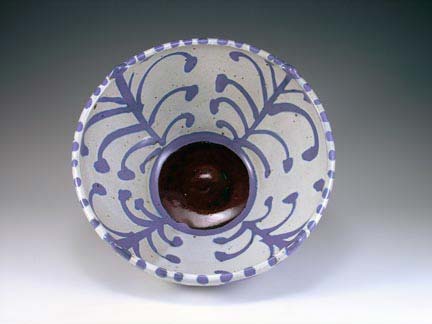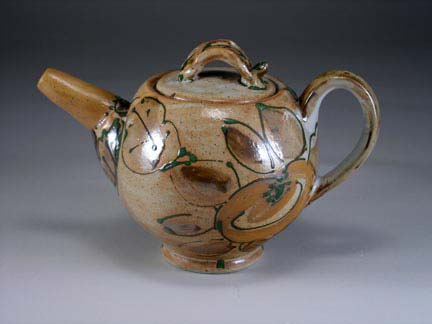January 3rd, all too soon, I leave to teach a 2-week class at Curaumilla Art Center in Chile with high-fire potter Suze Lindsay. I’ve known Suze since she came to Louisiana State University as a grad student, and appreciate her sense of decoration and boundless good humor. We only overlapped for one year before I left the L.S.U. faculty to move to Florida and marry Leland Shaw (then an Architecture Professor at U.F. and a part-time potter). Ever since that time, we’ve felt we didn’t get enough time working together, and have wanted to work in studio together. The Curaumilla program is a great opportunity to come together with other potters who want to talk about form and surface in a beautiful place for 2 weeks.
At Curaumilla, the trail has been blazed by wood-fire potters like Doug Casebeer and Randy Johnston, and Chris Gustin and Ron Meyers have also taught there. Suze and I wanted to expand the glaze palette to include more hue and value contrasts and more variety in color. The Curaumilla people dry-glaze and once-fire with wood. Hmmm. This should be a challenge. I think I’ll have to pot more thickly for my pots to survive dry-glazing.
The glazes we’ve been looking at are common cone 10 reduction glazes, like Emily Purple, shinos, saturated irons like Ohata Kaki. The research in Frank and Janet Hamer’s book The Potter’s Dictionary of Materials and Techniques, and Robert Fournier’s Illustrated Dictionary of Practical Pottery say for once-fire dry glazing, clay content in glazes should be 10-20% (for leatherhard about 50%). Our glazes often has less clay, occasionally more. It was fun for me to be able to use glaze calculation to change the clay content in the raw glaze but keep the glaze oxides in the fired glaze the same. I’m just enough of a materials and glaze calc nerd to get myself in trouble, but I enjoy the informaton and the challenge.
Richard Burkett, (potter, sculptor, San Diego State U faculty, materials guru, computer nerd, and musician) wrote HyperGlaze, originally a Mac-only program. It now runs on either PC or Mac platforms. It’s a lovely program, with a good-looking user interface and helpful support programs.
Although I’ve used HG, I find I use a PC-only program, GlazChem, by Bob Wilt, most often. Perhaps it’s from familiarity, but I find the layout (while not beautiful) very functional. I have some glazes that can be imported into GlazChem posted on my website handouts page and a link to the patch that will let you use the help files in Windows 7. Note, when you install GlazChem, you have to right-click and do RUN AS ADMININSTRATOR, and ditto the first time you run it. GlazChem will let you try the program before you buy, and the cost is a nominal $35.00.
With the help of GlazChem, I re-calculated some of my favorite U.F. cone 10 shop glazes to have about 10% clay. They don’t have frit in Curaumilla, and I read in my research materials that wood ash, although a raw material, is frit-like. Good solution. Cheap. They use it in China often. Ash will deflocculate the glaze and it should be flocculated with Epsom Salts to fix this before glazing. Ceramic Arts Daily video about doing this here.
Wishing everyone happy holidays. It’s a positive and optimistic challenge to create things. Below, some high-fire decorated works I’ve done. On the top 2, glazing method ws something I learned from Bill Brouillard: dip in Emily Purple, wax a design. Let the wax dry a bit, then wash off under the faucet all that is not waxed. Dry the piece overnight. Dip in a second glaze. Use a sponge to remove dots of glaze from wax. The Emily Purple is a magnesium-fluxed matt that will turn cobalt to purple. Where it overlaps with the celadon, the magnesium is diluted enough to make it shiny and back to blue. I love the blue line margin that happens.



Oh that first purple plate is wonderful, have a great trip to Chili.
Thanks! Should be a great adventure. Yes, time to celebrate Solstice by toasting the setting sun to help it come up again after the longest night of the year.
Neat to see your work at the other end of the firing range…different but still very much yours.
I am sure you will be too busy to post while you are away. However, I do hope for photos and descriptions when you return.
Have a wonderful Solstice, Christmas, etc. It sounds like you will spend most of it getting ready.